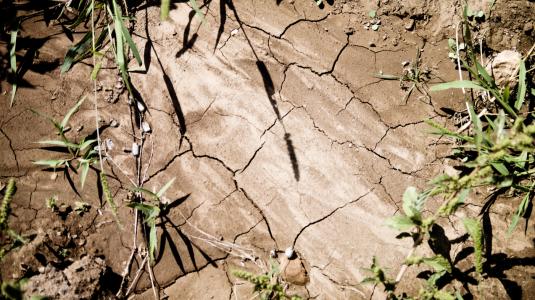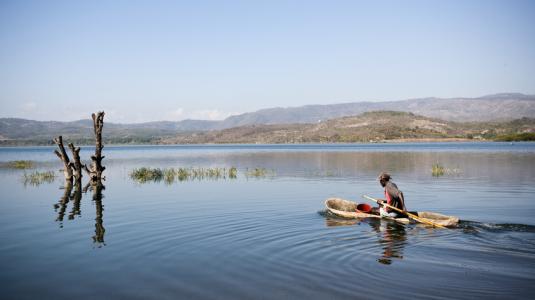Site Assessment

© GIZ, Site Assessment
For siting of industries economic factors, such as availability of raw materials, market for finished product, transportation networks, water supply, electricity, labour availability etc., the environmental factors, such as possible adverse effects on biodiversity, natural resources, and ecosystem services, exposure to climate hazards and short- as well as long-term impacts of climate change, and social factors need to be considered.
The industries are to be benchmarked by the degree of pollution potential. Relating their degree of potential risk with the distance to site sensitivities, the suitable sites can be found. To make the tool cost effective, the assessments are undertaken at regional level followed by at site level. The regional level or macro level studies eliminate unsuitable areas and identify potential alternate sites/zones for which detailed micro level studies are then conducted to arrive at the best suitable site.
The best practice examples and manuals from India help to apply guidelines to take environmental aspects into account when setting up new industrial parks. Thus, environmental regulatory authorities are specially addressed.
Consideration of climate change aspects (Climate Risk Assessment) is presented in more detail in the Climate Change Section.
Main features and components
Ideally, the planning of industrial areas should follow a three-step approach:
(1) a regional assessment to identify potential industrial sites/zones;
(2) a subsequent detailed comparative site suitability assessment of these pre-selected sites; and finally,
(3) the selection the best suited one for implementation planning.
The regional assessment is geared to identify sites suitable for siting of industries at a regional level and follows a three-step approach which is reflected in the guideline.
- In the first step environmental sensitive zones to be avoided for location of industries or to be protected from direct impacts of industrial activities are identified. Part A of the Guidelines for Regional Environmental Assessment provides criteria to be considered in this selection analysis; i.e. the biological diversity of an area, and sensitive or incompatible land uses.
- After having eliminated these sensitive zones, the remaining areas are classified according to their suitability for location of industries. The suitability is assessed using the sensitivity of the areas against two types of industrial impacts: Air pollution, and water pollution. Parts B and C of the Guidelines for Regional Environmental Assessment provide criteria to be considered in this suitability analysis.
- The last step of the regional assessment is the synthesis of the preceding steps to compile a regional suitability assessment for the siting of industries. Part D. of the Guidelines for Regional Environmental Assessment provides guidance for the implementation of the synthesis analysis.
- In days of climate change the regional assessment should be further supported by climate adaptation and mitigation related considerations. These are further detailed in the Climate Change Section.
A regional assessment requires a minimum of data and information input. Only in a few cases respective environmental databases or atlases might be available. The Themes for State and District Environmental Atlases provide reference data catalogues to facilitate data collection.
To consistently execute the subsequent detailed site suitability assessment, more detailed information on the industries to be sited is required. The core task of this step is to benchmark the environmental sensitivity of the pre-selected sites against the environmental performance and impacts of the industries to be sited. In fact, the approach applied at the regional level is to be applied again in more detail on the local level using more detailed information and data.
As a pre-requisite criteria and rules for the definition of the pollution potential and environmental risk caused by the specific industries have to be agreed upon and defined.
Implementation and work steps
Topics for the regional assessment:
Regional level environmental assessments (Macro-level Zoning Atlas studies) in 1:250,000 scale taking into consideration:
- Physical and geographical aspects of land, viz. land use, drainage, topography, soils etc.
- Sensitive zones to be avoided, including legally restricted areas, environmentally sensitive areas, sensitive areas based on historic/religious/social considerations.
- Air pollution sensitivity based on land use sensitivity, dispersion sensitivity (topography, meteorology) and pollution potential of industries.
- Surface water pollution sensitivity based on flow in rivers/lakes, water use sensitivity (public supplies, drinking etc.), water quality and pollution potential of industries.
Identification of a search area from the suitable areas of macro-level studies in 1:250,000 scale taking into consideration:
- Land availability - extent of land to suit to the industrialisation demand, preferably wastelands
- Land ownership - government or private land lease in acquisition
- Electricity - nearness or distance of various pre-final sites from nearest existing sub-station/power plant
- Nearness to the major settlement - distance of nearest major settlement from all the pre-final candidate sites
- Water availability - distance from source of water supply for domestic and industrial purposes
- Distance from existing industrial areas
- Distance from sensitive zone
- Drainage - distance of major rivers or drains from the pre-final sites
- Nearness to transportation network for economic handling of both raw materials and finished goods
- Environmental sensitivity of the area to suit to the needed industrial development
- Transportation facility: distance from existing railway line and highway
Results of the regional assessment:
- Identification of areas to be avoided for siting of industrial estates
- Identification of candidate sites based on socio-economic factors from the areas other than those areas to be avoided.
- Rapid environmental assessment of the candidate sites and identification of potential site(s)
- Assessment of sensitivity of land use and air/water pollution sensitivity and suitability to industries
- Recommendations on:
- Site(s) for industrial estates
- Suitability to industries
Topics for the detailed local site suitability assessment:
Mapping of the study area (25 km around the candidate site) in 1:50,000 scale, including:
- Base Map
- Village reference Map
- Land use/Land cover Map
- Slope Map or Drainage Map
- Hydrogeomorphology Map
- Existing industries map
- Infrastructure map (transportation network, water availability, electricity etc.)
- Air quality map
- Surface water quality map
- Ground water quality map
- Environmentally sensitive zones and resource areas
- Land use development concept around the site
Lessons learnt
The Central Pollution Control Board, Delhi (apex body in India for prevention & control of pollution, an agency under the Indian Ministry of Environment & Forests) has undertaken regional level assessments (Zoning Atlases) for over 150 districts in India and identified potential zones for siting of industries and industrial estates.
Requirements
- Information about the environmental impact of industries.
- Detailed geographical information about the land and its attributes (geography, drainage, hydro- geomorphology etc.), surface and ground water features, environmentally sensitive zones, major sources of pollution and environmental quality attributes.
- The willingness of the stakeholders, industries or industrial park developer for sustainable land allotment.
- Information about the environmental impact of industries
- Detailed geographical information about the land and its attributes (geography, drainage, hydro- geomorphology etc.), surface and ground water features, environmentally sensitive zones, major sources of pollution and environmental quality attributes
- The willingness of the stakeholders, industries or industrial park developer for sustainable land allotment
Output
The exact analysis of the environmental situation will give first ideas about future impacts on the natural environment and the local community as well as requires limits and preventive measures to minimise the risks.
Guideline for decision makers including industrial park developers, industrial entrepreneurs, regulatory authorities and public use.
Downloads
Characteristics
Phase of intervention
Introducing SIA, Analysis, Designing SIA, Master planning
Level of intervention
Planning level
Regions
Asia
Countries
India
Target groups
Industrial area management and operator, Local and international consultant and advisor, Municipality, Private investors

